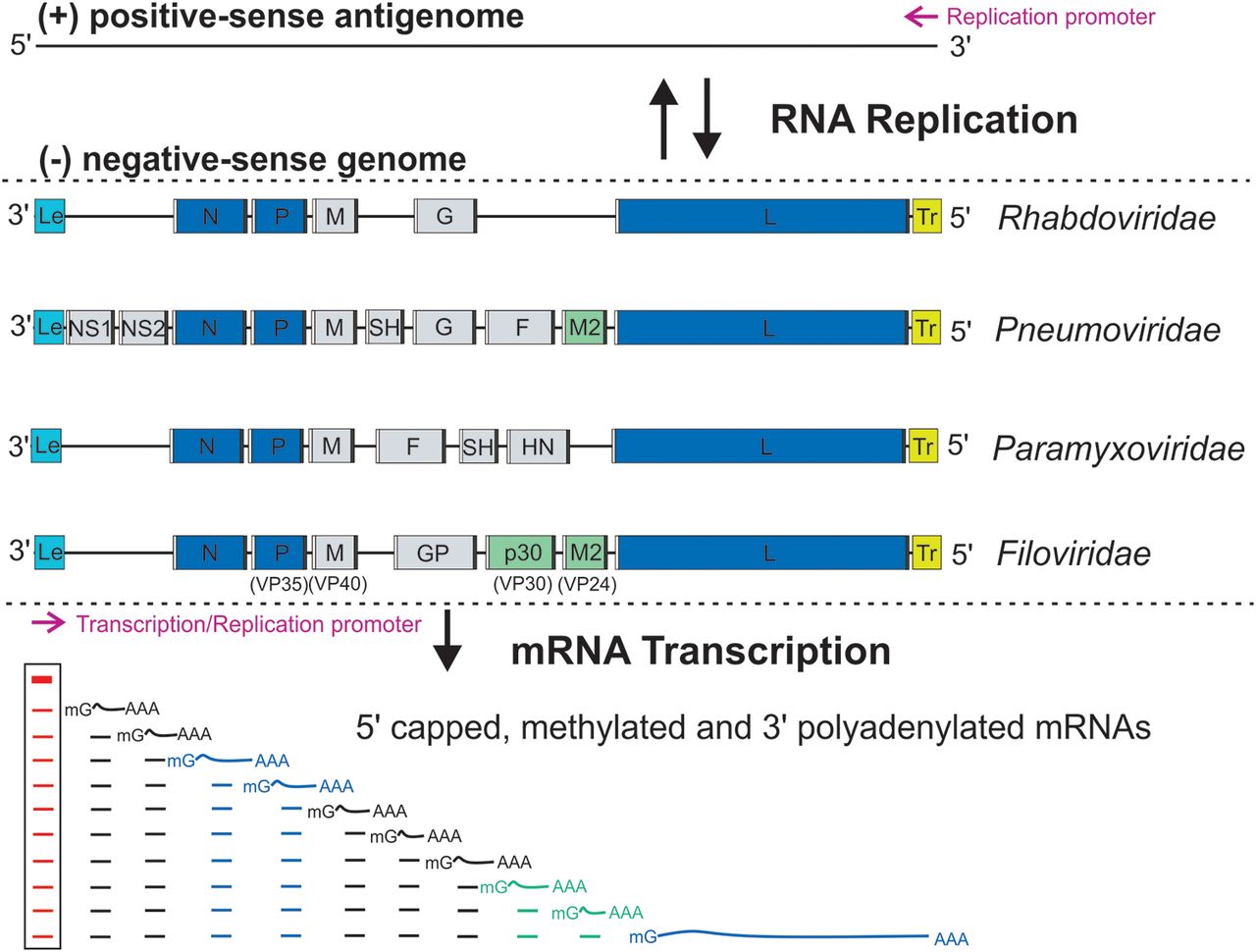|
Lyssavirus
''Lyssavirus'' (from the Greek ''lyssa'' "rage, fury, rabies" and the Latin '' vīrus'') is a genus of RNA viruses in the family ''Rhabdoviridae'', order ''Mononegavirales''. Mammals, including humans, can serve as natural hosts. The genus ''Lyssavirus'' includes the rabies virus traditionally associated with the disease of the same name. Taxonomy Virology Structure Lyssavirions are enveloped, with bullet shaped geometries. These virions are about 75 nm wide and 180 nm long. Lyssavirions have helical symmetry, so their infectious particles are approximately cylindrical in shape. This is typical of plant-infecting viruses. Virions of human-infecting viruses more commonly have cubic symmetry and take shapes approximating regular polyhedra. The structure consists of a spiked outer envelope, a middle region consisting of matrix protein M, and an inner ribonucleocapsid complex region, consisting of the genome associated with other proteins. Genome Lyssavirus geno ... [...More Info...] [...Related Items...] OR: [Wikipedia] [Google] [Baidu] |
West Caucasian Bat Lyssavirus
''West Caucasian bat lyssavirus'' (WCBL) is a member of genus ''Lyssavirus'', family ''Rhabdoviridae'' and order ''Mononegavirales''. This virus was first isolated from ''Miniopterus schreibersii,'' in the western Caucasus Mountains of southeastern Europe in 2002. WCBL is the most divergent form of ''Lyssavirus'', and is found in ''Miniopterus'' bats (insectivorous), ''Rousettus aegyptiacus'', and ''Eidolon helvum''. The latter two are both fruit bats. The virus is fragile as it can be inactivated by UV light and chemicals, such as ether, chloroform, and bleach. WCBL has not been known to infect humans thus far. Classification The lyssavirus genus can be divided into four phylogroup {{Short pages monitor [Baidu] |
Mononegavirales
''Mononegavirales'' is an order of negative-strand RNA viruses which have nonsegmented genomes. Some common members of the order are Ebola virus, human respiratory syncytial virus, measles virus, mumps virus, Nipah virus, and rabies virus. All of these viruses cause significant disease in humans. Many other important pathogens of nonhuman animals and plants are also in the group. The order includes eleven virus families: '' Artoviridae'', ''Bornaviridae'', ''Filoviridae'', ''Lispiviridae'', ''Mymonaviridae'', ''Nyamiviridae'', ''Paramyxoviridae'', ''Pneumoviridae'', ''Rhabdoviridae'', '' Sunviridae'', and ''Xinmoviridae''. Use of term The order ''Mononegavirales'' (pronounced: ) According to the rules for taxon naming established by the International Committee on Taxonomy of Viruses (ICTV), the name ''Mononegavirales'' is always to be capitalized, italicized, and never abbreviated. The names of the order's physical members ("mononegaviruses" or "mononegavirads") are to be writte ... [...More Info...] [...Related Items...] OR: [Wikipedia] [Google] [Baidu] |
Rabies Virus
Rabies virus, scientific name ''Rabies lyssavirus'', is a neurotropic virus that causes rabies in humans and animals. Rabies transmission can occur through the saliva of animals and less commonly through contact with human saliva. ''Rabies lyssavirus'', like many rhabdoviruses, has an extremely wide host range. In the wild it has been found infecting many mammalian species, while in the laboratory it has been found that birds can be infected, as well as cell cultures from mammals, birds, reptiles and insects. Rabies is reported in more than 150 countries on all continents, with the exclusion of Antarctica. The main burden of disease is reported in Asia and Africa, but some cases have been reported also in Europe in the past 10 years, especially in returning travellers. ''Rabies lyssavirus'' has a cylindrical morphology and is a member of the ''Lyssavirus'' genus of the ''Rhabdoviridae'' family. These viruses are enveloped and have a single stranded RNA genome with negative-se ... [...More Info...] [...Related Items...] OR: [Wikipedia] [Google] [Baidu] |
Rabies Lyssavirus
Rabies virus, scientific name ''Rabies lyssavirus'', is a neurotropic virus that causes rabies in humans and animals. Rabies transmission can occur through the saliva of animals and less commonly through contact with human saliva. ''Rabies lyssavirus'', like many rhabdoviruses, has an extremely wide host range. In the wild it has been found infecting many mammalian species, while in the laboratory it has been found that birds can be infected, as well as cell cultures from mammals, birds, reptiles and insects. Rabies is reported in more than 150 countries on all continents, with the exclusion of Antarctica. The main burden of disease is reported in Asia and Africa, but some cases have been reported also in Europe in the past 10 years, especially in returning travellers. ''Rabies lyssavirus'' has a cylindrical morphology and is a member of the ''Lyssavirus'' genus of the ''Rhabdoviridae'' family. These viruses are enveloped and have a single stranded RNA genome with negative-se ... [...More Info...] [...Related Items...] OR: [Wikipedia] [Google] [Baidu] |
Australian Bat Lyssavirus
''Australian bat lyssavirus'' (''ABLV''), originally named ''Pteropid lyssavirus'' (''PLV''), is a zoonotic virus closely related to the rabies virus. It was first identified in a 5-month-old juvenile black flying fox (''Pteropus alecto'') collected near Ballina in northern New South Wales, Australia, in January 1995 during a national surveillance program for the recently identified Hendra virus. ABLV is the seventh member of the genus ''Lyssavirus'' (which includes ''Rabies virus'') and the only ''Lyssavirus'' member present in Australia. Prevalence ABLV is distributed throughout Australia in a variety of bat species which are believed to be the primary reservoir for the virus. Surveillance initiatives also confirmed the presence of lyssavirus in both Pteropid (Gould ''et al.''., 1998) and insectivorous bats (Gould ''et al.''., 2002; Hooper ''et al.''., 1997), and later, human infections were reported following encounters with both fruit and insectivorous bats (Allworth ''et ... [...More Info...] [...Related Items...] OR: [Wikipedia] [Google] [Baidu] |
Rabies
Rabies is a viral disease that causes encephalitis in humans and other mammals. Early symptoms can include fever and tingling at the site of exposure. These symptoms are followed by one or more of the following symptoms: nausea, vomiting, violent movements, uncontrolled excitement, fear of water, an inability to move parts of the body, confusion, and loss of consciousness. Once symptoms appear, the result is virtually always death, regardless of treatment. The time period between contracting the disease and the start of symptoms is usually one to three months but can vary from less than one week to more than one year. The time depends on the distance the virus must travel along peripheral nerves to reach the central nervous system. Rabies is caused by lyssaviruses, including the rabies virus and Australian bat lyssavirus. It is spread when an infected animal bites or scratches a human or other animals. Saliva from an infected animal can also transmit rabies if the saliva come ... [...More Info...] [...Related Items...] OR: [Wikipedia] [Google] [Baidu] |
European Bat 2 Lyssavirus
''European bat 2 lyssavirus'' (EBLV-2) is one of three rabies virus-like agents of the genus ''Lyssavirus'' found in Daubenton's bats (''Myotis daubentonii'') in Great Britain.Johnson N, Vos A, Neubert L, Freuling C, Mansfield KL, Kaipf I, Denzinger A, Hicks D, Núñez A, Franka R, Rupprecht CE, Müller T, Fooks AR. Experimental study of European bat lyssavirus type-2 infection in Daubenton's bats (''Myotis daubentonii'') in the U.K. J Gen Virol. 2008 Nov;89(Pt 11):2662–72. Human fatalities have occurred: the naturalist David McRae who was bitten by a Daubenton's bat in Scotland, became infected with EBLV-2a and died in November 2002. It must now be assumed that the virus is present in bats in the UK. Testing of dead bats by MAFF/DEFRA over the last decade indicates that the overall incidence of infection is likely to be very low, although limited testing of live Daubenton's bats for antibodies suggests that exposure to EBLV-2 may be more widespread. Nevertheless, infected bat ... [...More Info...] [...Related Items...] OR: [Wikipedia] [Google] [Baidu] |
Lagos Bat Lyssavirus
''Lagos bat lyssavirus'', formerly Lagos bat virus (LBV) is a ''Lyssavirus'' of southern and central Africa that causes a rabies-like illness in mammals. It was first isolated from a fruit bat (''Eidolon helvum'') from Lagos Island, Nigeria in 1956. Brain samples from the bat showed poor cross-reactivity to rabies antibodies but the virus was found to be closely related to the rabies virus. This was the first discovery of a rabies-related virus. Until this time, rabies was thought to have a single causal agent. ''Lagos bat lyssavirus'' has been isolated from wild and domestic mammals in southern Africa including bats, cats and one dog. One isolate was detected in France in 1999 when a fruit bat (''Rousettus egypticus ''Rousettus'' is a genus of Old World fruit bats or megabats, referred to as rousette bats. The genus is a member of the family Pteropodidae. The genus consists of seven species that range over most of Africa to southeast Asia, and the islands ...''), which had ... [...More Info...] [...Related Items...] OR: [Wikipedia] [Google] [Baidu] |
Mokola Lyssavirus
''Mokola lyssavirus'', commonly called Mokola virus (MOKV), is an RNA virus related to rabies virus that has been sporadically isolated from mammals across sub-Saharan Africa. The majority of isolates have come from domestic cats exhibiting symptoms characteristically associated to rabies virus infection. As of 2021, there have been two confirmed cases of Mokola virus infection in humans, of which one was fatal. The rabies vaccine does not confer cross-protective immunity to Mokola virus, and no other known treatment for MOKV exists. Classification Mokola virus (MOKV) is a member of the genus ''Lyssavirus'', which belongs to the family ''Rhabdoviridae''. MOKV is one of four lyssaviruses found in Africa. The other three viruses are the classic rabies virus, Duvenhage virus and Lagos bat virus. Emergence MOKV was first isolated in Nigeria, in 1968, from three shrews (''Crocidura'' species) found in the Mokola forest, Ibadan, Oyo State, Nigeria. The virus was shown to be morpholo ... [...More Info...] [...Related Items...] OR: [Wikipedia] [Google] [Baidu] |
Bokeloh Bat Lyssavirus
''Bokeloh bat lyssavirus'' (BBLV) is negative-sense, single-stranded RNA virus of the genus ''Lyssavirus'' first isolated from a Natterer's bat (''Myotis nattereri'') found in Bokeloh, Lower Saxony, Germany Germany,, officially the Federal Republic of Germany, is a country in Central Europe. It is the second most populous country in Europe after Russia, and the most populous member state of the European Union. Germany is situated betwe ... in 2010. References Lyssaviruses Zoonoses {{virus-stub ... [...More Info...] [...Related Items...] OR: [Wikipedia] [Google] [Baidu] |
Shimoni Bat Lyssavirus
''Shimoni bat lyssavirus'' is a ''Lyssavirus'' which was discovered in Kenya in 2009. It bears significant similarities to the ''Lyssavirus'' '' Lagos bat virus''. The virus was isolated from the brain of a dead Commerson's leaf-nosed bat ('' Hipposideros commersoni''), which is likely the natural reservoir In infectious disease ecology and epidemiology, a natural reservoir, also known as a disease reservoir or a reservoir of infection, is the population of organisms or the specific environment in which an infectious pathogen naturally lives and r ... of the virus. References Lyssaviruses Bat virome {{virus-stub ... [...More Info...] [...Related Items...] OR: [Wikipedia] [Google] [Baidu] |
Rhabdoviridae
''Rhabdoviridae'' is a family of negative-strand RNA viruses in the order ''Mononegavirales''. Vertebrates (including mammals and humans), invertebrates, plants, fungi and protozoans serve as natural hosts. Diseases associated with member viruses include rabies encephalitis caused by the rabies virus, and flu-like symptoms in humans caused by vesiculoviruses. The name is derived from Ancient Greek , meaning rod, referring to the shape of the viral particles. The family has 40 genera, most assigned to three subfamilies. Structure The individual virus particles (virions) of rhabdoviruses are composed of RNA, protein, carbohydrate and lipid. They have complex bacilliform or bullet-like shapes. All these viruses have structural similarities and have been classified as a single family. The virions are about 75 nm wide and 180 nm long. Rhabdoviruses are enveloped and have helical nucleocapsids and their genomes are linear, around 11–15 kb in length. Rhabdoviruses c ... [...More Info...] [...Related Items...] OR: [Wikipedia] [Google] [Baidu] |




.jpg)
